-
Countries
-
Data and Analysis
-
Special Focus
-
Crisis Responses

Contact
DTM Iraq, IraqDTM@iom.int
Language
English
Location
Iraq
Period Covered
May 01 2018
Sep 30 2021
Activity
- Mobility Tracking
- Baseline Assessment
From May 2018 to September 2021, 35,307 Iraqi returnees from abroad were identified in 17 Governorates, 69 Districts and 635 locations. During this reporting period, IOM Iraq achieved full country coverage.
Most of the returnees from abroad were recorded in the governorates of Ninewa (45%), Thi-Qar (42%) and Anbar (5%). Of those returnees recorded in Ninewa, 66 per cent were recorded in the district of Telafar, while 24 per cent were recorded in Sinjar. In Thi-Qar, 88 per cent were recorded in the district of Nassriya, while 7 per cent were recorded in Suq Al-Shoyokh. Finally, in Anbar, 51 per cent returned to the district of Ana while 26 per cent were in Al-Ka'im. The majority of returnees (56%) were identified as having come from two countries: Turkey (36%) and the Syrian Arab Republic (20%).
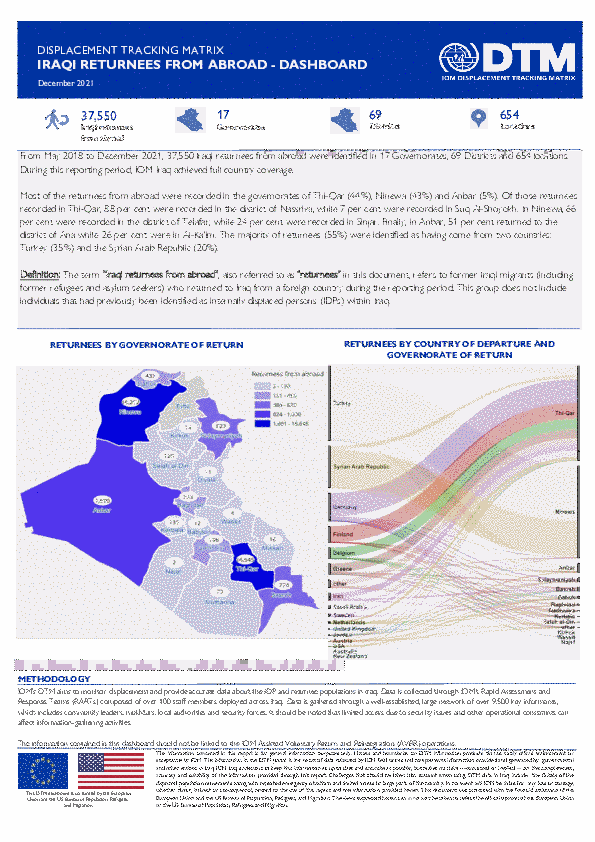
Contact
DTM Iraq, IraqDTM@iom.int
Language
English
Location
Iraq
Period Covered
May 01 2018
Dec 31 2021
Activity
- Mobility Tracking
- Baseline Assessment
From May 2018 to December 2021, 37,550 Iraqi returnees from abroad were identified in 17 Governorates, 69 Districts and 654 locations. During this reporting period, IOM Iraq achieved full country coverage.
Most of the returnees from abroad were recorded in the governorates of Thi-Qar (44%), Ninewa (43%) and Anbar (5%). Of those returnees recorded in Thi-Qar, 88 per cent were recorded in the district of Nassriya, while 7 per cent were recorded in Suq Al-Shoyokh. In Ninewa, 66 per cent were recorded in the district of Telafar, while 24 per cent were recorded in Sinjar. Finally, in Anbar, 51 per cent returned to the district of Ana while 26 per cent were in Al-Ka'im. The majority of returnees (55%) were identified as having come from two countries: Turkey (35%) and the Syrian Arab Republic (20%).

Contact
DTM Iraq, IraqDTM@iom.int
Language
English
Location
Iraq
Period Covered
May 01 2018
Mar 31 2022
Activity
- Mobility Tracking
- Baseline Assessment
From May 2018 to March 2022, 40,332 Iraqi returnees from abroad were identified in 17 Governorates, 69 Districts and 664 locations. During this reporting period, IOM Iraq achieved full country coverage.
Most of the returnees from abroad were recorded in the governorates of Thi-Qar (46%), Ninewa (42%) and Anbar (4%). Of those returnees recorded in Thi-Qar, 88 per cent were recorded in the district of Nassriya, while 7 per cent were recorded in Suq Al-Shoyokh. In Ninewa, 64 per cent were recorded in the district of Telafar, while 22 per cent were recorded in Sinjar. Finally, in Anbar, 51 per cent returned to the district of Ana while 26 per cent were in Al-Ka'im. The majority of returnees (51%) were identified as having come from two countries: Turkey (33%) and the Syrian Arab Republic (18%).
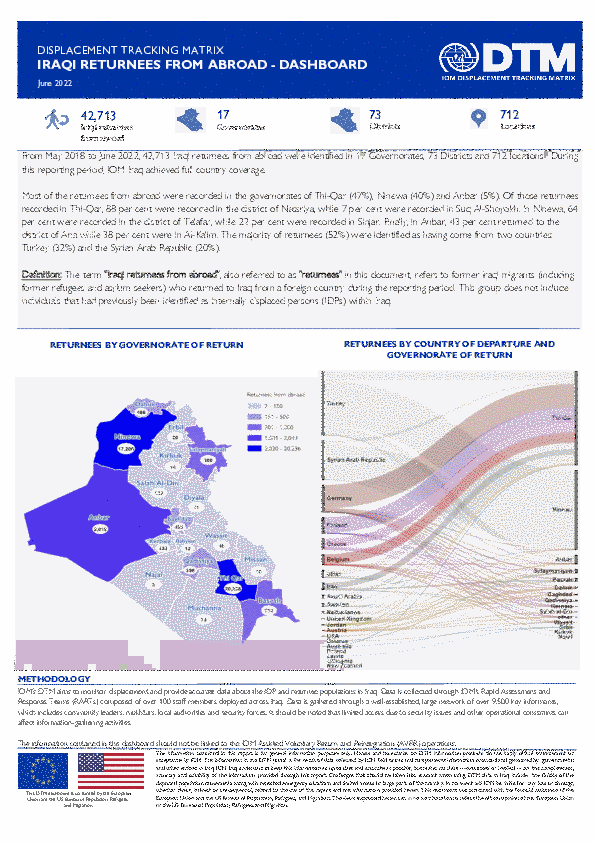
Contact
DTM Iraq, IraqDTM@iom.int
Language
English
Location
Iraq
Period Covered
May 01 2018
Jun 30 2022
Activity
- Mobility Tracking
- Baseline Assessment
From May 2018 to June 2022, 42,713 Iraqi returnees from abroad were identified in 17 Governorates, 73 Districts and 712 locations. During this reporting period, IOM Iraq achieved full country coverage.
Most of the returnees from abroad were recorded in the governorates of Thi-Qar (47%), Ninewa (40%) and Anbar (5%). Of those returnees recorded in Thi-Qar, 88 per cent were recorded in the district of Nassriya, while 7 per cent were recorded in Suq Al-Shoyokh. In Ninewa, 64 per cent were recorded in the district of Telafar, while 22 per cent were recorded in Sinjar. Finally, in Anbar, 43 per cent returned to the district of Ana while 38 per cent were in Al-Ka'im. The majority of returnees (52%) were identified as having come from two countries: Turkey (32%) and the Syrian Arab Republic (20%).
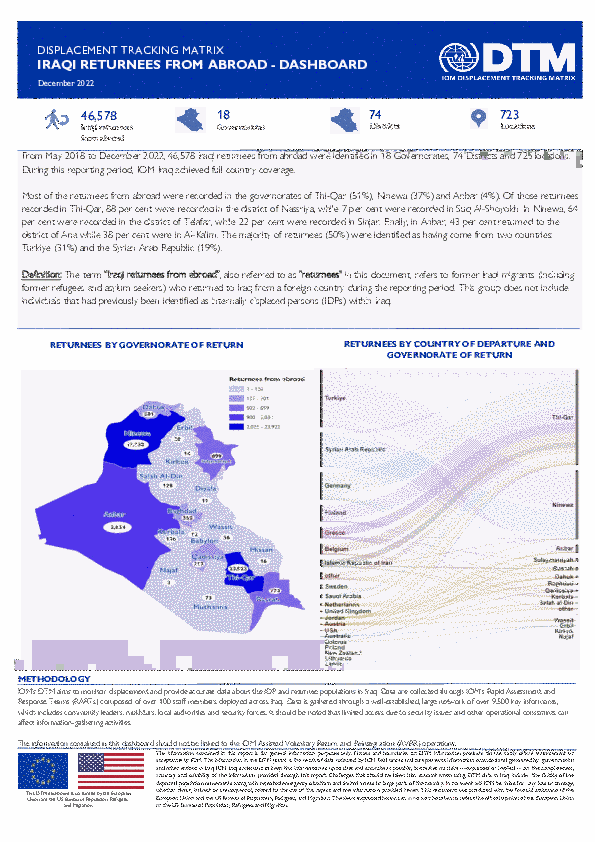
Contact
DTM Iraq, IraqDTM@iom.int
Language
English
Location
Iraq
Period Covered
May 01 2018
Dec 31 2022
Activity
- Mobility Tracking
- Baseline Assessment
From May 2018 to December 2022, 46,578 Iraqi returnees from abroad were identified in 18 Governorates, 74 Districts and 723 locations. During this reporting period, IOM Iraq achieved full country coverage.
Most of the returnees from abroad were recorded in the governorates of Thi-Qar (51%), Ninewa (37%) and Anbar (4%). Of those returnees recorded in Thi-Qar, 88 per cent were recorded in the district of Nassriya, while 7 per cent were recorded in Suq Al-Shoyokh. In Ninewa, 64 per cent were recorded in the district of Telafar, while 22 per cent were recorded in Sinjar. Finally, in Anbar, 43 per cent returned to the district of Ana while 38 per cent were in Al-Ka'im. The majority of returnees (50%) were identified as having come from two countries: Turkiye (31%) and the Syrian Arab Republic (19%).
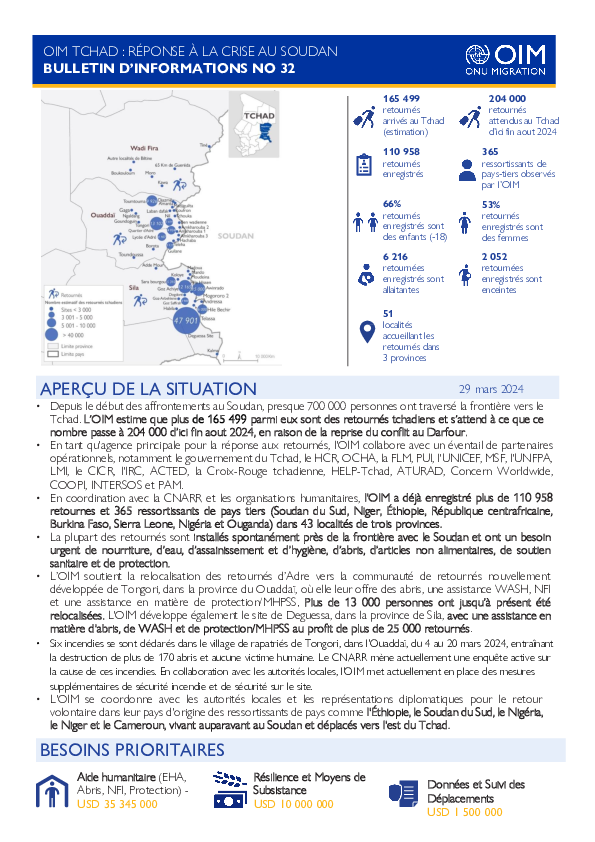
Contact
DTM Iraq, IraqDTM@iom.int
Language
English
Location
Iraq
Period Covered
May 01 2018
Apr 30 2023
Activity
- Mobility Tracking
- Baseline Assessment
From May 2018 to April 2023, 48,536 Iraqi returnees from abroad were identified in 18 Governorates, 74 Districts and 726 locations. During this reporting period, IOM Iraq achieved full country coverage. Most of the returnees from abroad were recorded in the governorates of Thi-Qar (53%), Ninewa (36%) and Anbar (4%). Of those returnees recorded in Thi-Qar, 88 per cent were recorded in the district of Nassriya, while 7 per cent were recorded in Suq Al-Shoyokh. In Ninewa, 64 per cent were recorded in the district of Telafar, while 22 per cent were recorded in Sinjar. Finally, in Anbar, 42 per cent returned to the district of Ana while 38 per cent were in Al-Ka'im. The majority of returnees (48%) were identified as having come from two countries: Turkey (30%) and the Syrian Arab Republic (18%).
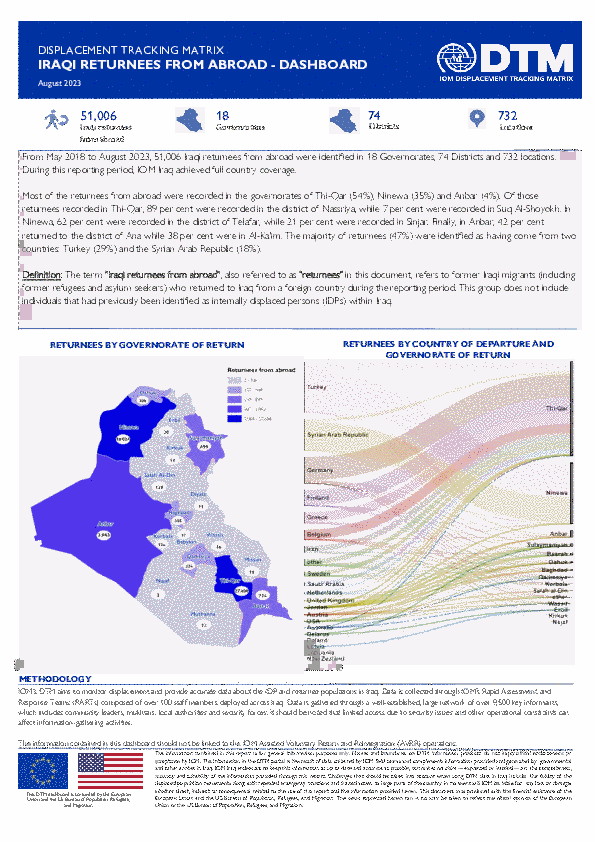
Contact
DTM Iraq, IraqDTM@iom.int
Language
English
Location
Iraq
Period Covered
May 01 2018
Aug 01 2023
Activity
- Mobility Tracking
- Baseline Assessment
From May 2018 to August 2023, 51,006 Iraqi returnees from abroad were identified in 18 Governorates, 74 Districts and 732 locations. During this reporting period, IOM Iraq achieved full country coverage. Most of the returnees from abroad were recorded in the governorates of Thi-Qar (54%), Ninewa (35%) and Anbar (4%). Of those returnees recorded in Thi-Qar, 89 per cent were recorded in the district of Nassriya, while 7 per cent were recorded in Suq Al-Shoyokh. In Ninewa, 62 per cent were recorded in the district of Telafar, while 21 per cent were recorded in Sinjar. Finally, in Anbar, 42 per cent returned to the district of Ana while 38 per cent were in Al-Ka'im. The majority of returnees (47%) were identified as having come from two countries: Turkey (29%) and the Syrian Arab Republic (18%).
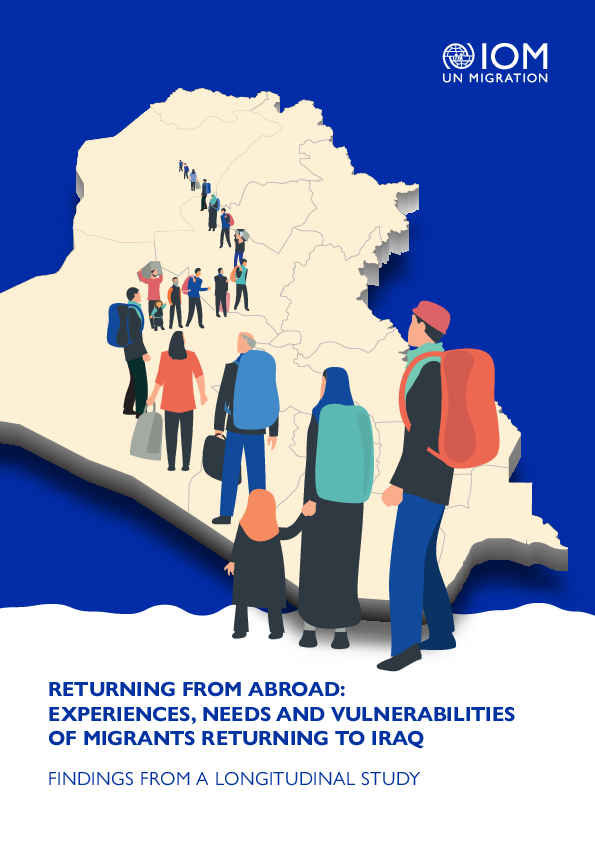
Contact
IraqDTM@iom.int
Language
English
Location
Iraq
Period Covered
Aug 01 2020
Aug 31 2021
Activity
- Survey
- Flow Monitoring
Migration from Iraq is multifaceted, characterized by different flows of emigration. In the post-2003 period, Iraqi nationals were mostly migrating to neighbouring countries, such as Jordan, Syria, Lebanon, and Iran. In the following years, outgoing migration has turned towards Turkey and countries outside the region, such as the United States, Canada, and Australia, as well as European countries like Germany, Greece and Finland. Migration has been connected to waves of conflict-driven displacement resulting from the Iraq-Iran War (1980-1988), the Gulf War (1990-1991), the US occupation of Iraq and sectarian war (2003-2011), and the armed conflict against the Islamic State of Iraq and the Levant (2013-2017). Beyond fuelling international movements, the latter conflict also resulted in around 6 million of internally displaced people. Throughout these periods, migration has been used as a strategy to overcome economic instability, political unrest, and the lack of security, equality, and social justice in Iraq; however, others have migrated abroad for economic, health or business reasons.
Iraqi migrants are estimated to be more than 2 million, and return migration from abroad is an increasingly important dimension of the Iraqi migration landscape. After the end of the sectarian war and the conflict against the Islamic State, many Iraqis decided to return voluntarily. Moreover, among those who have emigrated as asylum seekers, not all of them have obtained a protection status (such as refugee status) that allows them to remain in the host country; frequently, such people are hence forced to return to Iraq. As of December 2022, approximately five million Iraqi nationals have returned from abroad. However, the exact number of Iraqi returnees is difficult to establish because not all of them have returned through programmes of assisted voluntary return and flows are thus difficult to track. Little is known about the conditions faced by returned migrants in Iraq. Due to the lack of statistical data and research, it is not possible to have a comprehensive picture of the challenges faced by nationals upon return, or their challenges of reintegrating in Iraq.

Contact
IraqDTM@iom.int
Language
English
Location
Iraq
Period Covered
Jun 01 2020
Aug 31 2020
Activity
- Survey
- Flow Monitoring
DTM Iraq collects data at border crossing points with neighboring countries – the Islamic Republic of Iran (Iran), the Syrian Arab Republic (Syria) and Turkey – to better understand migration movements in the Middle East. Cross-border monitoring is drawn from IOM’s DTM standard methodology, designed to capture and describe migration flows, and is part of IOM’s DTM Regional Evidence for Migration Analysis and Policy (REMAP) project, funded by the European Union, which aims to capture and describe migration flows in Afghanistan, Bangladesh, Iran, Iraq and Pakistan. Data displayed in this report was collected in June, July and August 2020, employing two approaches: 1) headcount of all travellers entering or leaving Iraq, and 2) survey of randomly sampled travellers.
Border crossing points were selected based on observations conducted in May 2019 by IOM’s Rapid Assessment and Response Teams (RARTs), when five border crossing points were selected for data collection: Ibrahim Al-Khalil, bordering Turkey, Fishkhabour, bordering Syria, and Bashmagh Zurbatiyah (Wassit Terminal) and Al-Shalamcha, bordering Iran. Due to mobility restrictions imposed by Iraqi authorities since March 2020 aimed at curbing the spread of the coronavirus disease 2019 (COVID-19), data collection took place at three out of five selected border points in June, July and August 2020. Further details on the selection of respondents, survey methodology, and how the border crossing points were selected are available in the Methodological Overview in the last section of this report.
The report presents an overview of the overall movements of travellers observed at any of three selected border crossing points during June, July and August 2020. It is also focused in more detail on those travellers who are crossing the border for three or more months – they are referred to as migrants and comprise 49 per cent of all recorded travellers. Findings presented in this report relate to sociodemographic characteristics, reasons for travel and mobility history of this category of travellers.

Contact
DTM Iraq, IraqDTM@iom.int
Language
English
Location
Iraq
Period Covered
May 01 2020
Jul 31 2020
Activity
- Survey
- Displacement Solutions
- Mobility Tracking
This brief is part of a larger research project, Cities as Home, carried out by IOM Iraq, the Returns Working Group, and Social Inquiry, that explores both drivers and deterrents of integration across 14 urban locations that still host the largest share of IDPs in the country. The outputs of this project also include an analysis report on determinants of integration for IDPs and host community members, factsheets for each location, and four detailed case studies.